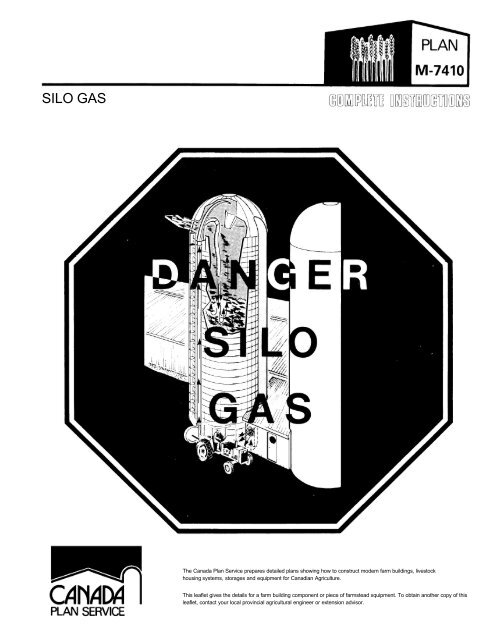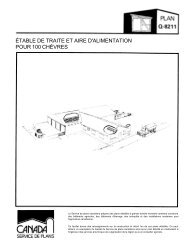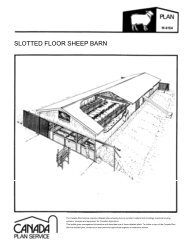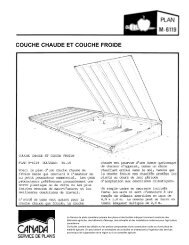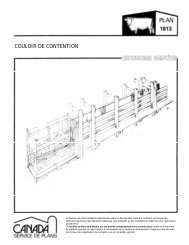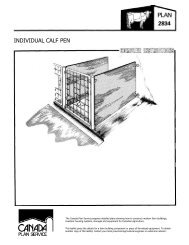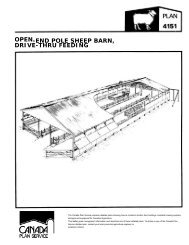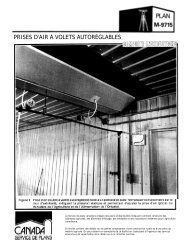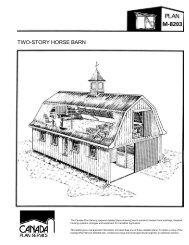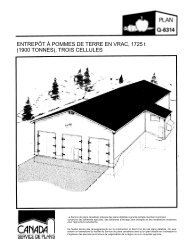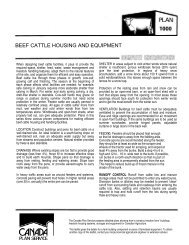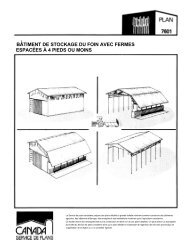Silo Gas Leaflet (Metric and Imperial) - Canada Plan Service ...
Silo Gas Leaflet (Metric and Imperial) - Canada Plan Service ...
Silo Gas Leaflet (Metric and Imperial) - Canada Plan Service ...
Create successful ePaper yourself
Turn your PDF publications into a flip-book with our unique Google optimized e-Paper software.
SILO GASThe <strong>Canada</strong> <strong>Plan</strong> <strong>Service</strong> prepares detailed plans showing how to construct modern farm buildings, livestockhousing systems, storages <strong>and</strong> equipment for Canadian Agriculture.This leaflet gives the details for a farm building component or piece of farmstead xquipment. To obtain another copy of thisleaflet, contact your local provincial agricultural engineer or extension advisor.
SILO GASPLAN M -7410 REVISED 88:06FOREWORDIn 1977, near Gananoque, Ontario, the Conners wereharvesting their corn crop somewhat early because of plannedhighway construction nearby. On Monday, September 12, theycontinued filling the silo but stopped on Tuesday because ofrain.On Wednesday, September 14, they decided to resumeharvesting. The silage distributor had not been adjusted <strong>and</strong>silage had piled about 5 m higher against the silo wall at thechute side. From there it sloped steeply downwards towardsthe opposite side. Edward Conner (a son) apparently decidedto level the silage <strong>and</strong> adjust the distributor before restartingfilling operations. Because all the chute doors were closedexcept the top one, he decided instead to go in through the roofopening. Using a 7 m rope ladder, he let himself down the 9 mdrop.Jack Conner (the father) returned from town at about 11:00a.m. <strong>and</strong> noticed that Edward was missing. A hired man,William Carr, climbed the outside silo ladder, looked in,shouted that something was wrong, then jumped in. He l<strong>and</strong>edpart way up the silage slope.Hearing Carr's shout, Jack Conner climbed the outside ladder;he saw Edward lying at the bottom of the slope <strong>and</strong> Williamlying part way up. Mr. Conner yelled out that the boys were introuble. Another brother, Eldon Conner, ran from the house<strong>and</strong> up the silo chute, followed by another hired man, DonLittlejones. Eldon kicked in two silo doors <strong>and</strong> entered. Hetried without success to move Carr, then went farther down theslope to help his brother, Edward, <strong>and</strong> collapsed beside him.The father watched all of this from the top of the outside ladder!Don Littlejones tried twice to pull Carr up to the silo chute. Jackwent back down the outside ladder, started up the tractor <strong>and</strong>forage blower to ventilate the silo, then went up the chute.Firemen <strong>and</strong> ambulance (called by Mrs. Conner) arrived on thescene.Then the tractor running the blower ran out of fuel. Littlejoneschanged tractors, but broke a shear-pin when restarting theblower. This had to be replaced before silo ventilation could becontinued. The am bulance attendant tried to climb the silochute with an air-pack, but it was too big for the chute <strong>and</strong> hadto be dropped. Without the air-pack, his rescue attempts werefutile.The bodies of the three men were finally removed with anaerial platform, from which were suspended two ladders lashedtogether <strong>and</strong> lowered through the roof door to reach the silagesurface.At the corner's inquest, the forensic scientist reported that thevictims' lungs showed massive bleeding <strong>and</strong> contained highlevels of methemoglobin, evidence of exposure to a strongoxidizing agent. This was attributed to nitrogen dioxide (N02),or silo gas.Another more recent case emphasizes that N02 is not the onlygas hazard in farm silos. In 1987, Wayne Smith, a farmemployee of Dwight Gilmer <strong>and</strong> Sons, South Mountain,Ontario, entered a tower silo. It had been lined with asuspended plastic bag, converting the silo to anoxygen-limiting storage for high moisture shelled corn. Smithwas working between the concrete wall <strong>and</strong> the slack plasticliner above the corn, tramping down some corn that remainedaround the inside perimeter of the bag after the last of the freeflowingcorn had been augered out.Apparently the liner ripped open at one of the seams, perhapsspilling C02 gas into the space where Smith was working. Hisbody was found some time later, where he had tumbledthrough the ripped liner <strong>and</strong> into the gas -filled space inside.These tragic events remind farmers <strong>and</strong> silo service people ofthe deadly nature of the gases sometimes found in <strong>and</strong> aroundfarm silos. This publication explains the silo gas problem <strong>and</strong>gives some safety rules for preventing further accidents of thiskind.RECOMMENDED PROCEDURES - A SUMMARY1. POST A WARNING SIGN in an obvious place such as onthe feed room door or beside the silo chute. Many silobuilders provide such signs, some with operatinginstructions warning of gas <strong>and</strong> injury hazards peculiar totheir own br<strong>and</strong> of silo. The message can be quite simple,such as DANGER, SILO GAS.2. Check to see if your LOCAL FIRE DEPARTMENT (orsimilar emergency service) has the pressure dem<strong>and</strong>breathing apparatus with a long air-hose for suchemergencies. Diving gear (SCUBA) is not suitablebecause the back-pack air tank is too big to be worn whileclimbing the silo chute or the outside ladder-cage.3. VENTILATE THE FEED ROOM in case silo gas spills outof the silo doors or is blown out by the silo unloader.4. During silo filling operations DON'T GO INTO THE SILOjust to level the silage; instead, make adjustments to thesilage distributor at the top of the silo to keep the silageleveled during filling.5. It is sometimes necessary to go into a silo after filling(such as to level <strong>and</strong> tramp the silage, install a plasticcover sheet, or to setup the silo unloader). DO THIS ASSOON AS THE LAST LOAD IS PUT IN, AND LEAVE THEBLOWER RUNNING while inside. Don't wait until the nextday. When opening a chute door into the silo, climb fartherup the chute (not down), in case silo gas spills out of thedoorway.
6. Previous bulletins have recommended a safety harness(or at least a loop of rope under the armpits) with a ropeleading to a helper at the top (the 'buddy system'). Thiswas not a bad idea, but if you fall, ONE PERSON ALONECOULD NEVER PULL YOU UP THE SILO WALL <strong>and</strong> outthrough the roof hatch or silo chute doors to safety. Twohelpers is the minimum!7. Before entering a previously-filled silo, check the depth ofthe settled silage. To make sure that the air-blast isreaching all the way down into the headspace, attach atube adaptor to the blower pipe (see Figures 4 <strong>and</strong> 5).Leave the chute doors closed <strong>and</strong> VENTILATE THE SILOby running the forage blower. Larger silos <strong>and</strong> deeperheadspaces require more ventilation time (see Table 1).KEEP THE BLOWER RUNNING while you are in the silo.8. Once operating, the silo unloader can ventilate the siloquite effectively. However, if the silo unloader fails <strong>and</strong>requires service in a recently filled silo, one must assumethat some gas may have accumulated. In this case,reventilate with the forage blower- <strong>and</strong> drop-pipe as inrecommendation 7, above.9. If you discover someone collapsed in the silo, the first <strong>and</strong>most important step is to start the forage blower <strong>and</strong>VENTILATE THE SILO. Providing a fresh air supply is themost positive <strong>and</strong> immediate help to both victim <strong>and</strong>rescuers.10. As soon as the victim is outside in the fresh air, APPLYARTIFICIAL RESUSCITATION, if necessary, to restorebreathing. Obtain medical assistance.11. Chemical gas detectors presently available are accurateenough but they are not suitable for operators who do notalso have the remote air supply equipment for silo entry.Tests for C02 <strong>and</strong> NOx, should be carried out using twotubes for each gas. Take samples just above the lowestpoint of the silage surface.12. Oxygen-limiting silos are a special case. If you have toenter one of these silos for any reason, you must wear anexternal air supply. This consists of a pressure tank, asupply hose long enough to reach into the silo, a'pressure-dem<strong>and</strong>' type of supply regulator <strong>and</strong> a full-facemask.The acid content of the silage continues to increase over aperiod of several weeks (depending on the chemistry of thesilage material <strong>and</strong> the air tightness of the silo). Eventually, theincreasing acidity kills off the acid-forming bacteria thatproduced it <strong>and</strong> inhibits the growth of molds <strong>and</strong> fungus thatcould further damage the silage as feed. This is the normalsilage making process which takes place in a silo with reasonablyairtight walls. ONE SILAGE GAS (C02) IS ALWAYSPRODUCED in this process. The period of most rapid gasproduction is during the first 6-7 days after filling. During thisperiod the total volume of the various gases represents severaltimes the volume of the silo! For the next 3-4 weeks the gasproduction tapers off. Some gases stay trapped within thesilage during the storage period <strong>and</strong> silage settlementcontinues to squeeze the gases into the headspace above(see Figure 1).Another family of gases, the OXIDES OF NITROGEN (NOX),can also be produced. Any weather condition, cultural practiceor silage additive that increases the dissolved nitrate (N03)content of the plant material also raises the risk of producingthis group of deadly gases. The period of greatest danger is upto 3 weeks after filling.For example, a drought period during the corn growing seasoncan cause a buildup of nitrate in the soil <strong>and</strong> the corn plants.The corn is then harvested before the thirsty plants canconvert the nitrate into useful food proteins, <strong>and</strong> the unwantednitrogen is released as nitrous oxide (N20) <strong>and</strong> nitric oxide(NO). The N20 is produced in only minor quantities <strong>and</strong> isrelatively harmless (laughing gas, an anaesthetic), but the NOis another matter. This unstable NO gas can be produced inconsiderable quantities <strong>and</strong> it quickly combines with anyoxygen remaining in the silo headspace, forming deadling N02gas.Other factors that can increase the nitrate content of silage arenitrogen fertilizer overdose (including manure), black soils thatare high in organic matter, <strong>and</strong> silage additives containingnitrate nitrogen (for increasing the protein equaivalent of cattlefeed). For example, the Conners, prior to their accident, hadbeen pumping ammonium nitrate solution through the forageblower while filling the silo. Urea is another nitrogen chemicalsometimes used this way.MAKING SILAGEFresh silage material (corn, grains, grasses or legumes), whenchopped <strong>and</strong> blown into silos, is living plant material. Duringthe ensiling process this living material quickly uses up thelimited supply of atmospheric: oxygen entrapped within thecompressed silage mass, <strong>and</strong> dies. In this respiration processthe oxygen is converted into some water <strong>and</strong> carbon dioxide(C02). At the same time, acid-forming anaerobic microbesmultiply rapidly in the warm moist silage. They feed on part ofthe sugars <strong>and</strong> starches in the silage material <strong>and</strong> convertthem to organic acids (lactic, acetic, etc.). These acid-formingbacteria also produce more C02.SILO GAS PROPERTIESCARBON DIOXIDE (C02) is not itself damaging to health. Itsdanger lies in the factthat in silos <strong>and</strong> similar tight spaces itreplaces the oxygen of the air (normal air is about 21%oxygen, 79% nitrogen <strong>and</strong> 0.03% carbon dioxide). Inoxygen-limiting silos, the contained atmosphere will be almostentirely C02 <strong>and</strong> nitrogen (N2); human survival in thisatmosphere depends entirely on a safe, external air supply.Carbon dioxide is an odorless, tasteless, colorless gas that is53% heavier than air. Humans <strong>and</strong> animals fortunately have abuilt-in warning system for C02; when it reaches a certainconcentration in the bloodstream, it triggers a nervous impulse
<strong>and</strong> the victim gasps for air. At higher concentrations this reflexaction is inhibited <strong>and</strong> the victim is asphyxiated. The C02'threshold limit value' (TLV-STEL, explained later) is 15 000ppm (parts per million), or 1.5% by volume.In conventional top-unloading silos with roofs, C02 canaccumulate to dangerous concentrations when trapped at lowpoints near the silage surface, <strong>and</strong> this risk should not bedisregarded (see Figures 1 <strong>and</strong> 2).NITROGEN DIOXIDE (N02) is a deadly gas, appearing as areddish to yellowish-brown haze, with an acrid or bleach-likeodor. Like C02, it is heavier than air (its relative density is 1.58,or 58% heavier), so it too accumulates at low points in the siloheadspace, feed room, feed alleys, etc. The threshold limitvalue (TLV-STEL) is set at only 5 ppm. At this level it is barelydetectable by smell. When produced in sufficient quantities it isso dangerous that it can be a threat to man <strong>and</strong> beast byspilling over into the silo chute <strong>and</strong> draining down into the feedroom <strong>and</strong> connecting stable.Nitrogen dioxide is deadly because when inhaled it dissolveswith moisture on the wetted internal surfaces of the lungs,instantly forming potent nitric acid (4N02 + 2H20 + 02 -> 4HN03).Here it 'burns' the sensitive oxygen-transfer surfaces of thelungs, effectively stopping any further oxygen supply to the1 silo chute doors, closed for filling2 top of silage just after filling3 settled silage4 dense silo gas, squeezed out of the silage,remains in the headspace1 wind blows through open roof hatch <strong>and</strong> topof chute, ventilates silo dome <strong>and</strong> top ofheadspace2 highest concentration of silo gas is at thelowest part of the headspace3 workman opens chute door, silo gas poursdown into chuteFigure 1 Typical unsealed tower silo just after filling Figure 2 Behavior of silo gas on opening of a silo chutedoor
ody. Tiny blood vessels in the lungs break down, causingmassive bleeding, <strong>and</strong> death results (When Eldon Conner wentdown the sloping silage to try to rescue his brother, his fatherwatched him drop unconscious almost immediately. Even ifrescue could have been completed within minutes, it is veryunlikely that either Eldon or Edward could have been revived).Even small periodic dosages of N02 (such as from workingeach day in a poorly-ventilated feed room at the bottom of thesilo chute) has been blamed for a host of chronic respiratoryproblems, including shortness of breath, coughing <strong>and</strong> fluid inthe lungs. These symptoms can also result from a singlenon-lethal exposure <strong>and</strong> may be first noticed several weeksafterwards. This delayed effect has sometimes made anaccurate diagnosis difficult.Another of these pumps, made by Drager in Germany (Figure3), consists of a small h<strong>and</strong>-squeezed rubber bellows fittedwith check valves. One or more specified strokes of thebellows are required, depending on the concentration of thegas (the weaker the mix the more strokes to be counted).Research showed that the Drager bellows type was easier touse than the piston type <strong>and</strong> more suitable for the wide rangesof temperature <strong>and</strong> humidity encountered in <strong>and</strong> around farmsilos. Consult the Drager chemical tube specifications <strong>and</strong> takespecial care when interpreting the readings at temperaturesbelow freezing.DETECTING SILO GASESDuring the danger period after filling the silo, use the followingsilo gas indicators:• Acrid bleach-like odor or a brownish to yellowish haze at thesilage surface or on the feed room floor can indicate nitrogendioxide. Sometimes an unnatural bright-yellow to orangecoloration in the silage is another indicator.• Unnatural breathing, or coughing of livestock <strong>and</strong> people,may indicate either N02 or C02, or both.• Dead flies, cats or mice on the feed room floor, or dead birdsin the silo, may indicate silo gases. Animals on the floor willbe exposed to heavier gas concentrations than a st<strong>and</strong>ingperson.In addition, chemical detectors are available for manyhazardous gases, including C02, combined NO <strong>and</strong> N02 (NOX),<strong>and</strong> N02 alone. The simplest of these is a paper tape thatchanges color when exposed to N02 in silos <strong>and</strong> feed rooms,but it doesn't indicate how much gas is present. The tape istherefore not recommended.CHEMICAL TUBE DETECTORS, on the other h<strong>and</strong>, can becalibrated <strong>and</strong> should be considered for use by trainedtechnicians <strong>and</strong> rescue teams (firemen, etc.). This type ofdetector consists of a sealed glass tube containing a specificchemical reagent that changes color progressively along itslength when the gas in question is drawn through the tube.Each tube is activated by snapping off both ends of the glass<strong>and</strong> plugging it into a small h<strong>and</strong>-operated air pump. Operatinginstructions specify the number of pump strokes required todraw a specified air volume through the sampling tube. Thegas concentration is read either directly or by comparing thelength of tube that has changed color to tables or chartsreading in parts per million (ppm), by volume.Several approved br<strong>and</strong>s of tube detectors (MSA, Kitagawa,Drager, <strong>and</strong> <strong>Gas</strong>tec) are available at safety supply stores. Onetype of air pump consists of a piston <strong>and</strong> cylinder somewhatlike an oversized hypodermic syringe. One pull of the h<strong>and</strong>ledraws a precise quantity of the air in question (typically 100mL) through the chemical tube.Figure 3.Drager gas tester consisting of bellows pump,attached chemical tube <strong>and</strong> extension hose forremote sampling.A practical difficulty is that all of these chemical tube detectorsare calibrated with the glass tubes plugged directly into their airpumps. This means that the operator himself must enter thesilo or other danger area, which is hazardous unless he iswearing a remote air supply system. Use of the tube detectorwill give the best indication that it is safe for others to followwithout the protection of a remote air supply system. Forpractical purposes, an extension tube up to 5.5 m (18 ft) long(provided by the manufacturer) is probably accurate enoughwhen reading near the threshold limit values. At least twochemical tubes for each gas (C02 <strong>and</strong> NOX) should be used tocheck a silo. In many cases the extension tube is not nearlylong enough to reach from the safety of the outside silo ladderdown to the sampling point inside the silo.THRESHOLD LIMIT VALUES (TLV) are the upper safety limitsof hazardous gas concentrations. The American Conference ofGovernment <strong>and</strong> Industrial Hygienists (1980) has publishedtwo values: the TLV-TWA (time weighted average) value is theupper safety limit for workers repeatedly exposed for thetypical 8-hour workday; the TLV STEL (short-term exposurelimit) is the upper safety limit for four daily exposures of up to
15 minutes, separated by 1-hour periods of no exposure. Thelatest published values for silo gases are:TLV-TWA TLV-STEL(ppm) (%) (ppm) (%)Carbon dioxide (C02) 5000 0.5 15 000 1.5Nitric oxide (NO) 25 35Nitrogen dioxide (N02) 3 5Oxides of nitrogen(NOX) 3* 5*____* Based on the most dangerous possibility that all the NOX canconvert to N02VENTILATING THE SILO AND FEED ROOMPORTABLE EXHAUSTER FANS were tried in controlledexperiments with C02 in full-size farm silos. Two sizes ofelectric blowers were tested, each being connected to 15 m (50ft) of clothes-drier hose.This simple adaptation improved remarkably the penetration ofthe air-blast deep into the silo headspace. The makeshiftarrangement shown in Figure 2 was experimentally effective,but there is too much chance that in a real gas -hazardsituation the tube could be dislodged by air <strong>and</strong> vibration. Thiscould leave someone in the silo without a continuing airsupply. Therefore the tube should be tied securely in place.__'Spring Flex' tubing, by Flexhaust Co., 11 Chestnut St.,Amesbury, Mass., U.S.A. Available from Indus trial Rubberproducts, 90 Comm<strong>and</strong>er Blvd., Agincourt, Ont. M1S 3H7,<strong>and</strong> ForestTube Inc., 3555 boul. Cremazie E., Montreal,Que., H1Z 2S3.The larger blower was rated at 215 L/s when connected to thecollapsible tubing. Once in place <strong>and</strong> operating, it reduced theC02 concentration in the silo headspace to that of normal air(around 3000 ppm) in 15 to 20 minutes. However, it was quitedifficult to place the tubing at the far side of the silo whilest<strong>and</strong>ing safely in the ladder cage outside the roof. Probablyfew farmers would buy <strong>and</strong> routinely use such special-purposeequipment.THE FORAGE BLOWER can move more air than any othereasily-portable system, <strong>and</strong> it has the important advantage ofalready being in place at the end of silo filling. Air-movingcapacities of various forage blowers running 'empty' at ratedtractor speed were from 800 to 1000 L/s (1700-2100 cfm); thisis about five times the capacity of the larger portable exhausterthat was tested! After the initial 5-8 days of most rapid gasproduction, the forage blower is the most practical way toremove silo gases.A forage blower, equipped at the top of the silo with the side-filldeflector-type of silage spreader (Badger, Lancaster Multi-flo,etc.), is effective as long as the silage level is not more than 5m (16 ft) below the distributor hood. At greater headspacedepths, however, the splitter vanes appear to break up theairflow <strong>and</strong> prevent the air stream from penetrating deepenough to properly mix <strong>and</strong> displace the bad air deep insidethe silo.With the various types of rotating center-fill silage dis tributors(Even-flo, Butler, etc.) some of the air blast is lost from theopen underside of the long arched gooseneck, <strong>and</strong> the rotatingdistributor baffle-plate further deflects the remaining air-blasttoward the silo wall. With a center-fill spreader attached, theforage blower gives rather poor ventilation, especially wherethe headspace from distributor to silage is greater than 5 m.To better direct the air-blast downward <strong>and</strong> to preventinterference by the silage distributor (either type), a 5 m (16 ft)length of 200 mm (8 in.) wire-wound flexible exhaust ducting *was stuffed into the throat of the blower pipe (Figure 4).Figure 4.1 forage blower2 fixed filler pipe, 230 mm (9 in.)3 200 mm (8 in.) Spring Flex wire-woundtubing4 air blast penetrates to bottom of headspace5 mixed <strong>and</strong> diluted silo gas escapes throughopen roof hatch<strong>Silo</strong> ventilation by forage blower <strong>and</strong> flexibledrop-tube stuffed into throat of silo filler pipe
Really, a better method of attachment is required. Figure 5shows a suggested adaptor for the rotary center fill typedistributors. At this time, we are recommending to siloequipment manufacturers that they develop <strong>and</strong> market theseimportant safety devices.Another important fact was discovered. Contrary to popularopinion, we also found that the forage blower was moreeffective as a silo ventilator with all the CHUTE DOORSCLOSED <strong>and</strong> the ROOF PANEL OPEN.This procedure also avoids the dangerous possibility of the silogas simply moving from the silo down into the feed room <strong>and</strong>connecting stable.1 attachment fitting <strong>and</strong> rectangular-to-roundtransition piece; bolts to throat of gooseneck,bolt heads smooth <strong>and</strong> flush inside throat2 diverter flap-valve spring-loaded to 'open'position3 external crank <strong>and</strong> cable pulls valve to'bypass' position for ventilating the silo4 200 mm (8 in.) 'Spring Flex' wire-woundventilaon tubing, gear clamp to transitionpiece 1Figure 5.Proposed gooseneck attachment for diverting the ventilation down into the silo headspace (gooseneckdesign by Lancaster Level-Flo, Inc., Lancaster, Pennsylvania 17602, USA).
In an emergency, black plastic drainage tubing 200 mm (8 in.)diameter, without perforations, could be substituted for themore durable <strong>and</strong> lightweight wire-wound ventilation ducting.Table 1 gives calculated ventilation times for various sizes ofsilo headspace, assuming ventilation with a forage blower at800 L/s (full rated tractor pto speed of 540 rpm) <strong>and</strong> an initialgas concentration of 10% C02. In headspaces of 6 m (20 ft)<strong>and</strong> deeper, this table is valid only with the drop pipeattachment in place. Also, this table is not applicable to theperiod of most rapid gas production, for 5-8 days after filling -during this extreme danger period, even the forage blower istoo small to assure enough gas dilution for safety.TABLE 1 MINIMUM TIME TO VENTILATE TOWER SILOHEADSPACES<strong>Silo</strong> Ventilation time* (minutes) for headspacediameter _____________depths of________________3 m 4.5 m 6 m 7.5 m 9 mm (ft) (10 ft) (15 ft) (20 ft) (25 ft) (30 ft)3.6 (12) 3 4 5 7 84.8 (16) 5 7 9 11 136.0 (20) 7 10 14 17 217.2 (24) 10 14 20 25 29* based on C-Ci = e –KQt/VCo-Ciwhere C = C02 gas concentration at time t (assumed 0.015, theTLV-STEL)Ci = inlet C02 concentration (assumed 0.0003, as in freshair)Co = original C02 concentration (assumed 0.10 in theheadspace)K = mixing factor (assumed 1.0)Q = ventilation rate (assumed 48 m³/min)t = ventilation time, minV = headpsace volume, m³e = 2.718THE SILO UNLOADER (once installed <strong>and</strong> operating) is aneffective silo ventilator, but it provides no ventilation (<strong>and</strong>hence no protection) before it is lowered to the leveled silagesurface, adjusted <strong>and</strong> started up. This start-up time is,unfortunately, the time of greatest risk from silo gas.FEED ROOM VENTILATION is important as well. There is areal danger that silo gas can fill up to the level of the openchute doors <strong>and</strong> spill down the silo chute. This is of littleconsequence if the silo st<strong>and</strong>s alone outside <strong>and</strong> is connectedto the feed room with only a feed conveyer. In most cases,however, the silo chute connects directly through the roof of anattached feed room, <strong>and</strong> the feed room connects in turn withthe barn. Exhaust ventilation fans in the barn can easily drawsilo gases through the crack under the feed room door,endangering livestock as well as people. The problem ispotentially worse where the feed room floor is below outsideground level (a common situation with bank barns).This prevents effective natural ventilation that could beaccomplished by opening an outside feed room door.A simple <strong>and</strong> inexpensive solution is to move one of the barnexhaust fans (the one that runs most) to the feed room. Thiswill exhaust the barn air through the feed room, instead of thereverse. To make sure that the heavier-than-air silo gases areeffectively removed, build a box duct over the inside of the fan<strong>and</strong> extending down to about 150 mm (6 in.) from the feedroom floor. The opening areas of the duct cross-section <strong>and</strong>the inlet at the floor should each be at least twice that of thefan opening. The feed room should be insulated to preventcondensation on the walls <strong>and</strong> ceiling.A further advantage of this arrangement is that in winter thefeed room is heated at no cost by warm air drawn from thelivestock barn. It will be necessary to use some closure suchas a silage funnel attachment to close off the bottom of the silochute. This is to ensure that the fan will draw air from thestable, not from the silo. The silage funnel should be tied offwith a plastic bag (or other suitable closure) except when thesilo unloader is operated.REFERENCES1. Airborne Contaminants Committee. 1980. TLV's,threshhold limit values for chemical substances <strong>and</strong>physical agents in the workroom environment, withintended changes for 1980. Amer. Conf. of Govt. IndustrialHygienists, PO. Box 1937, Cincinnati, OH 45201, U.S.A.2. Wells, D. 1980. Respiratory protection for agriculturaltower silos <strong>and</strong> manure pits. Farm Safety Assoc. Inc., 340Woodlawn Rd. W., Guelph, Ont. N1H 7K6.3. Sabourin, H.M., W.S. Reid, J.E. Turnbull <strong>and</strong> M. Ihnat.1982. <strong>Silo</strong> gas production, detection, ventilation <strong>and</strong>related safety procedurs. Can. Soc. of Agric. Eng. paperno. 82-207, presented at ann. conf., Vancouver, B.C.Contribution no. I-421, from Eng. <strong>and</strong> Stat. Res. Center,Research Br., Agriculture <strong>Canada</strong>, Ottawa K1A OC6.4. Turnbull, J.E. 1984. <strong>Silo</strong> gas - what can be done? Proc.,Int. <strong>Silo</strong> Safety Conf., Kitchener, Ont. Nov. 28.Contribution no. I-660, from Eng. <strong>and</strong> Stat. Res. Center,Research Br., Agriculture <strong>Canada</strong>, Ottawa K1A OC6.5. Meiering, A.G., M.G. Courtin, S.F Spoelstra, G. Pahlow,H. Honig, R.E. Subden <strong>and</strong> E. Zimmer. 1988.Fermentation kinetics <strong>and</strong> toxic gas production of silages.Trans. of ASAE. Vol. 31.


